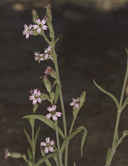notes This image shows the habitat here (growing in sand and relative shade beneath a tree canopy); and also the habitus of a mature plant (somewhat open architecture with long, lanky stems spreading-ascending to erect).
[Note: Further images from this Presidio population illustrate another multi-branched plant; a less common single-branched plant; a clump of basal leaves (before shoot development); an inflorescence with developing fruit; and a plant in early senescence with dehisced fruit capsules.]
Remarkably, much of the Presidio population of Silene verecunda occurs in tree canopy shade and appears to constitute a distinctive ecotype in that it grows in a substrate of almost pure sand (somewhat enriched by organic detritus from the tree canopy and to a lesser degree other nearby dune plants). Elsewhere in the San Francisco area (e.g. on Mt. Davidson and San Bruno Mountain) S. verecunda typically grows in more openly lit settings on rocky and/or clayey substrate.
These plants are perennial, usually branched from the base with one or more densely pubescent main stems bearing opposite leaves (below) and bracts (above) at well-spaced nodes. Young plants form rosette-like clusters of basal leaves, which are linear-oblanceolate, entire, acute, and become reddish with age...eventually whithering as the main stems grow and the plants mature. The lower cauline leaves are similar but a bit smaller and linear-oblanceolate to lanceolate, around 5-6 cm long and 4-7 mm wide; becoming reduced above and more narrowly linear; and with short, dense, white-pubescence (like the stems).
As is typical for members of Caryophyllaceae, the inflorescence here is cymose, i.e. after any stem tip produces a flower, growth at that position terminates and induces subsequent growth from the axillary buds of bractlets at (perhaps recently developed) nodes below that terminal flower. A stalk growing from such an axillary bud may end up becoming simply a pedicel (i.e. supporting a single terminal flower), or supporting a more elaborate inflorescence sub-unit (i.e. a stalk which produces, below its terminal flower, additional nodes with associated bracts, axillary buds, and subsequent stalks, etc.). And at any given node, either both members of an opposite pair of bracted axillary buds may produce an inflorescence stalk (i.e. dichasial growth), or only one such bracted bud may do so (i.e. monochasial growth). Repeated sequential development in this fashion is called sympodial growth.
In Silene verecunda different inflorescence sub-units (or 'cymules') can be mostly dichasial, mostly monochasial, or a mixture of the two...depending on a plant's developmental trajectory (and perhaps environmental conditions like the local geometry of available space, light, microclimate, etc.). And similarly, the pedicels & inflorescence branches of the cymules can take on a heterogenous mix of relatively long, short, or sessile lengths. This can make for a fairly non-uniform overall inflorescence structure both within a single plant, and across different plants. But a common pattern that seems to strike me in the Presidio and San Bruno Mountain populations of this species is that the lower flowering nodes along the main (shoot) stems typically support a fairly long inflorescence branch...and such branches tend to arise from just one of the two opposite bracts at those nodes. This is in contrast to the regionally sympatric species S. scouleri...where the inflorescence sub-units, both axillary and terminal, are more 'congested' (i.e. have relatively short or sessile pedicels & infloresence branches...even at later stages of growth when all such stalks have fully elongated). In S. verecunda the 'cymules' (i.e. inflorescence sub-units) are generally more open (i.e. have relatively longer pedicels and peduncles).
In these plants, the distal portions of the stems (i.e. inflorescences...and in particular pedicels & calyces) become more densely long glandular-pubescent. The calyces are about 10-13 mm, 10-nerved, and in fruit typically become constricted at their bases...and somewhat abruptly flared-out beyond. Petals (diagram of parts here) have white claws with rose-red tinged limbs (the limbs about 5 mm in length), cleft into two lobes each with either a small lateral tooth, or the tooth reduced to a bump-like 'shoulder' (or entirely absent). The appendages are two per petal, round to rectangular, a bit under 2 mm, obliquely truncate with distal edge entire to crenulate or lacerate. Flowers are protandrous, with two alternating 5-merous whorls of stamens. The (at least what usually appear to be) inner antesepalous whorl of 5 stamens lengthens and dehisces first, followed by the alternating 5 (what usually appear to be) outer antepetalous stamens. This developmental sequence is the reverse of the more common situation, and is referred to as ''secondary obdiplostemony'' in this 2016 paper. Anther dehiscence is followed by the lengthening of the style, spreading of the three apically-curling style branches, and maturation of the stigma lobes...which develop their pollen-receptive, papillate-pubescent upper surfaces from tip towards base. Fruit matures into a capsule that dehisces apically by six triangular valves. The seeds are intermediate in size, reniform, and very roughly textured.
These plants keys to S. verecunda in the Jepson eFlora, FNA, and Abrams. In the 1947 revision of Silene by Hitchcock & Maguire it keys to S. verecunda ssp. typica. Some aspects of the figures in Abrams and Hitchcock & Maguire don't match especially well...though perhaps that shouldn't be too surprising given the polymorphous nature of the species.
Links to each of these references appear below (in reverse chronological order):
Jepson eFlora: Silene key; S. verecunda treatment; Flora of North America (2005): Silene key; S. verecunda treatment; Hitchcock & Maguire Silene Revision (1947): Silene key; S. verecunda treatment + Figure 42; Abrams Flora (1944): Silene key ; S. verecunda treatment + Fig. 1745





